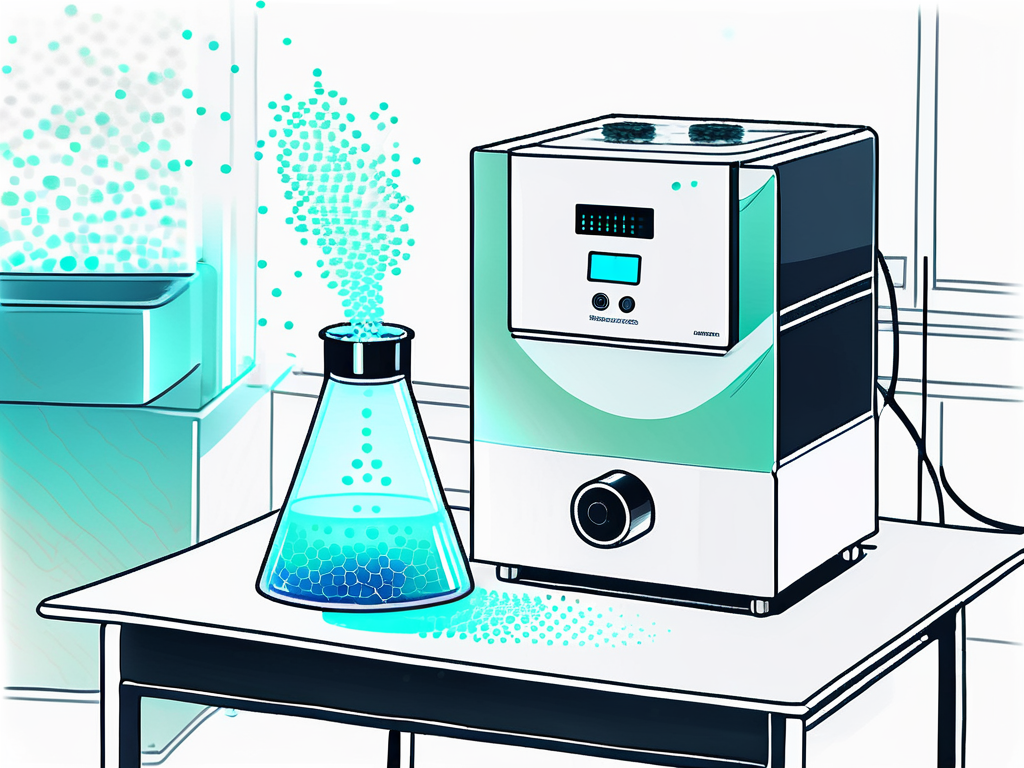Formaldehyde is a colorless, strong-smelling gas often found in aqueous solutions. Commonly used in manufacturing and chemical industries, it also occurs naturally in the environment and in our bodies. However, prolonged exposure to high levels of formaldehyde can be harmful, making it a significant concern for indoor air quality.
Understanding the sources, health effects, detection methods, and mitigation strategies for formaldehyde is crucial for maintaining a healthy indoor environment. This comprehensive glossary article will delve into these aspects in detail, providing a thorough understanding of formaldehyde in the context of indoor air quality.
What is Formaldehyde?
Formaldehyde is a volatile organic compound (VOC) that exists in both gas and liquid form. It is used in a wide range of products and processes due to its effective antiseptic and disinfectant properties. In its gaseous state, formaldehyde is colorless and has a pungent, irritating odor.
Formaldehyde is also a naturally occurring substance. It is produced in small amounts by most living organisms as part of normal metabolic processes. However, in larger quantities, it can be harmful to health, particularly when inhaled over extended periods.
Industrial Uses of Formaldehyde
Formaldehyde is used extensively in various industries. It is a key ingredient in the production of resins used in wood products, textiles, plastics, and coatings. Formaldehyde-based resins are commonly used in the manufacture of composite and engineered wood products, such as plywood, particleboard, and fiberboard.
Additionally, formaldehyde is used in the production of certain insulations, textiles, and as a disinfectant in some cleaning products. It is also used in the production of vaccines, fertilizers, and resins.
Natural Occurrence of Formaldehyde
Formaldehyde is produced naturally in the environment through the oxidation or combustion of organic compounds. For instance, forest fires and automobile exhaust contribute to the presence of formaldehyde in the outdoor environment.
Within the home, formaldehyde can be produced by cigarettes and other tobacco products, gas stoves, and open fireplaces. It is also emitted by certain types of wood and building materials.
Health Effects of Formaldehyde Exposure
Exposure to formaldehyde can lead to a variety of health effects. The severity of these effects depends on the concentration of formaldehyde in the air and the duration of exposure. Short-term exposure to high levels of formaldehyde can cause immediate symptoms such as eye, nose, and throat irritation, coughing, headaches, dizziness, and nausea.

Long-term or chronic exposure to lower levels of formaldehyde can lead to more serious health problems. These include respiratory issues, allergic reactions, and in some cases, cancer. Formaldehyde has been classified as a known human carcinogen by the International Agency for Research on Cancer (IARC).
Respiratory Effects
Formaldehyde is a potent mucous membrane irritant. When inhaled, it can cause a variety of respiratory symptoms including coughing, wheezing, chest tightness, and shortness of breath. In people with asthma, exposure to formaldehyde can trigger asthma attacks.
Chronic exposure to formaldehyde can also lead to more serious respiratory conditions such as bronchitis and pneumonia. In severe cases, it can cause pulmonary edema, a condition characterized by excess fluid in the lungs.
Allergic Reactions
Formaldehyde is a known allergen. Exposure can lead to a variety of allergic reactions, typically manifesting as skin conditions such as dermatitis. Symptoms include redness, swelling, and itching. In some cases, formaldehyde exposure can also trigger allergic reactions in the eyes and lungs.
Repeated skin contact with formaldehyde can lead to sensitization, making the individual more susceptible to future allergic reactions. In some cases, individuals can become sensitized to formaldehyde even at very low exposure levels.
Carcinogenic Effects
Long-term exposure to formaldehyde has been linked to certain types of cancer. The International Agency for Research on Cancer (IARC) classifies formaldehyde as a Group 1 carcinogen, indicating that it is carcinogenic to humans.
The most significant cancer risk associated with formaldehyde exposure is nasopharyngeal cancer, which affects the upper part of the throat behind the nose. Formaldehyde exposure has also been linked to leukemia, particularly myeloid leukemia.
Detection of Formaldehyde
Detecting the presence of formaldehyde in indoor air is crucial for maintaining a healthy environment. There are several methods available for formaldehyde detection, ranging from professional testing services to do-it-yourself test kits.

Professional testing services typically use sophisticated equipment and analytical methods to provide accurate and reliable results. These services can be costly, but they offer the most comprehensive assessment of formaldehyde levels.
Professional Testing Services
Professional testing services use a variety of methods to detect formaldehyde in indoor air. These methods include air sampling, where air samples are collected and sent to a laboratory for analysis. This is the most accurate method of formaldehyde detection.
Other professional testing methods include the use of real-time monitors, which provide immediate results. These devices use sensors to detect formaldehyde and other VOCs in the air. They are typically used in industrial settings, but can also be used in homes and offices.
DIY Test Kits
Do-it-yourself (DIY) test kits are a more affordable option for detecting formaldehyde in indoor air. These kits typically involve the use of a sampling device that is exposed to the air for a certain period. The device is then sent to a laboratory for analysis.
While DIY test kits are less accurate than professional testing services, they can still provide a general indication of formaldehyde levels. They are a good option for individuals who suspect they may have high levels of formaldehyde in their home or office, but do not have the resources for professional testing.
Reducing Formaldehyde Exposure
There are several strategies for reducing exposure to formaldehyde in indoor environments. These include improving ventilation, controlling humidity, using low-emitting products, and implementing air cleaning technologies.

It’s important to note that while these strategies can help reduce formaldehyde levels, they may not eliminate all sources of formaldehyde. Therefore, it’s essential to also focus on source control, such as avoiding the use of products that contain or release formaldehyde.
Improving Ventilation
Improving ventilation is one of the most effective ways to reduce indoor formaldehyde levels. This can be achieved by increasing the amount of outdoor air entering the building, using exhaust fans, and opening windows and doors when possible.
However, it’s important to consider the quality of the outdoor air. In areas with high outdoor air pollution, increasing ventilation could lead to an increase in the levels of other pollutants in the indoor air. Therefore, it’s important to balance the need for ventilation with the need to maintain overall indoor air quality.
Controlling Humidity
Formaldehyde emissions tend to increase with humidity and temperature. Therefore, controlling indoor humidity levels can help reduce formaldehyde emissions. This can be achieved by using dehumidifiers or air conditioners, particularly in humid climates or during humid seasons.
It’s recommended to maintain indoor humidity levels between 30% and 50% to minimize formaldehyde emissions and maintain overall indoor air quality. It’s also important to avoid activities that can increase indoor humidity, such as drying clothes indoors.
Using Low-Emitting Products
Many products used in homes and offices can emit formaldehyde. These include certain types of wood products, textiles, and cleaning products. Therefore, choosing low-emitting products can help reduce formaldehyde levels.
When purchasing products, look for labels that indicate low formaldehyde emissions. For example, wood products that meet the standards of the California Air Resources Board (CARB) Phase 2 are low-emitting. Additionally, certain certification programs, such as the GREENGUARD Certification, indicate that a product has low chemical emissions.
Implementing Air Cleaning Technologies
Various air cleaning technologies can help reduce formaldehyde levels in indoor air. These include air purifiers with activated carbon filters, which can absorb formaldehyde and other VOCs.
However, not all air cleaners are effective at removing formaldehyde. It’s important to choose an air cleaner that is specifically designed to remove formaldehyde and other VOCs. Additionally, air cleaners should be used in conjunction with other strategies, such as improving ventilation and controlling humidity, for the best results.



